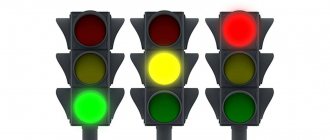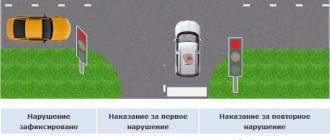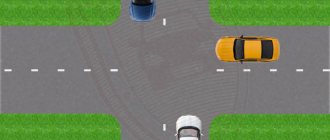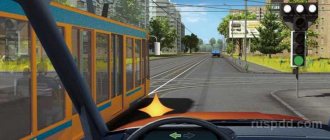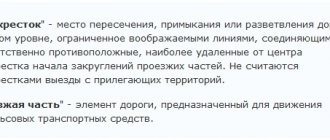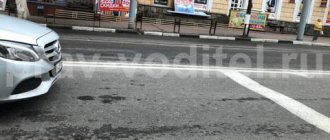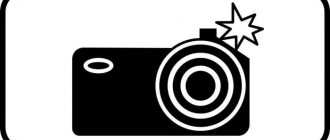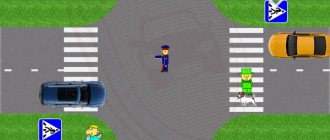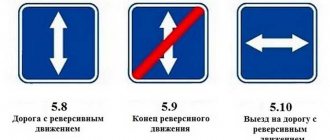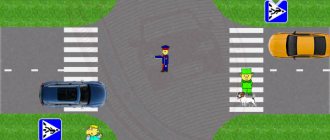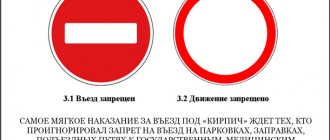You intend to turn left. Who should give way to?
| 1. | Pedestrians only. |
| 2. | Only by bus. |
| 3. | Buses and pedestrians. |
| 4. | No one. |
The intersection you are entering is a controlled intersection, and the traffic order at it is determined not by priority signs, but by traffic lights. When turning left, you must give way to a bus moving straight from the opposite direction, and, when completing the turn, to pedestrians crossing the road you are turning onto.
What are the priority signs?
Priority symbols mean giving priority to some vehicles over others if they are driving towards each other through an intersection or narrow section. Several designations fall into this category:
- 2.1. Shows that the road it belongs to is a main road. The symbol is placed on it before or after the intersection. In the second case, coverage area 2.1 extends to the section of the track along with the nearest road intersection. It can be completed by notation 2.2. Next to 2.1 there is a sign 8.3 showing the direction of the main road. If we are talking about a populated area, it is prohibited to park in its territory.
- 2.3.1. It is installed when necessary to show motorists that they are driving along a main road, which will soon intersect with a secondary one. Moreover, these directions are considered as such both on the right and on the left. The first to cross the convergence zone will be the one moving along the main road. It can also be used to overtake one vehicle by another. Cars traveling on secondary roads will have to give way to those traveling on the main route.
- 2.3.2-2.3.7. They indicate the junction of a secondary section with the main road. Each of the designations is set depending on the direction of the latter. And this is mainly done in places with difficult terrain outside populated areas, where the intersection of tracks is difficult to distinguish by drivers. Here the sign is placed 150-300 m before this point. In the city this distance is reduced to 50-100 m.
- 2.4. Those traveling in a secondary direction must obey him. After all, the symbol means the need to give way at the intersection to cars moving on the main road. 2.4 is placed near the intersection of paths, in front of this point. A duplicate sign can also be used at a longer distance in front of the intersection. Next to 2.4, place the symbol 8.3 if you need to indicate the direction of the main road.
A sign 8.1.1 is hung with the duplicate sign, which informs about the distance to the point of convergence of the paths. Instead it may be designated 8.1.2. In this case, we are talking about an intersection looming ahead, where movement without stopping is not allowed. After all, there will be a designation 2.5.
More on AutoLex.Net:
Correctly reading the “Speed Limit” sign
- 2.5. Warns the driver that he must stop at an intersection before reaching the stop line. And in her absence - at the edge of the intersection of paths. 2.5 may also be located near a railway crossing.
- 2.6. Necessary on narrow sections of the road, if the traffic is not one-way. The symbol indicates that the driver of a car moving on this side must give way to oncoming traffic. 2.6 does not apply to those types of equipment that, due to their dimensions, will not prevent the vehicle having the advantage from crossing a narrow segment. These are, for example, motorcycles.
- 2.7. This is the antagonist of the previous character. Installed on the opposite side of the road relative to 2.6. The symbol means that vehicles traveling in this lane have the right to cross the narrow section first. And the one who moves towards him must yield.
When driving straight ahead you:
| 1. | Must stop before the stop line. |
| 2. | You can continue through the intersection without stopping. |
| 3. | Must give way to vehicles coming from other directions. |
You are approaching a controlled intersection and can drive through it without stopping because the traffic light is green. You must comply with the stop sign requirement only if the traffic light is turned off or switched to flashing yellow mode.
Traffic rules about priority signs and traffic lights
Symbols 2.1-2.7 can be located not only at unregulated intersections, where everything is clear with them. They are also installed where there is a traffic light. Most people have known since childhood that they need to stand when the signal is red and continue moving when it turns green. But not everyone knows what to do if there are symbols 2.1-2.7 there.
Traffic lights and traffic priority signs are not equal. But the rules have a clear division of what and when is more important for the driver:
- If the traffic light is installed and in working condition, you need to obey it. Those for whom the green signal is on are the first to cross an intersection or narrow section. The others are waiting for him to appear for them. Priority symbols do not work in this case. All this is dictated by the second paragraph of clause 6.15 of the traffic rules:
If the meanings of traffic light signals contradict the requirements of priority road signs, drivers must be guided by the traffic light signals.
- If there is no traffic light, symbols take on meaning. They should be used to determine who goes first and who gives way. A non-working traffic light (it flickers or is turned off) makes the intersection unregulated. Then clause 13.3 of the traffic rules comes into effect:
When there is a flashing yellow signal, non-functioning traffic lights or the absence of a traffic controller, the intersection is considered unregulated, and drivers are required to follow the rules for driving through uncontrolled intersections and the priority signs installed at the intersection.
In what directions are you allowed to move?
| 1. | Just straight ahead. |
| 2. | Just straight and to the right. |
| 3. | Only straight, left and in the opposite direction. |
| 4. | In any. |
In this situation, the traffic controller does not change the existing traffic organization at the intersection. If you are in the right lane, you can only drive straight through the intersection, as the exit sign for a one-way road prohibits turning right. To make a left turn or U-turn, you had to take the left lane.
You are allowed to move:
| 1. | Just straight ahead. |
| 2. | In any direction. |
| 3. | Forward and to the right. |
Guided by the traffic lights, you could continue moving only to the right (traffic rules 6.3). However, in this situation, you must comply with the requirements of the traffic controller’s signals (Traffic Rules 6.15). When the right hand of the traffic controller is extended forward, then from his left side, taking into account your location (right lane) on the roadway, you can continue moving not only to the right, but also in the forward direction (Traffic Rules 6.10).
Which driver can continue driving?
| 1. | Only the driver of a passenger car. |
| 2. | Only the bus driver. |
| 3. | Both drivers. |
| 4. | Nobody. |
For some reason, the traffic controller took control of the traffic at the intersection. Drivers must comply with its signals, despite the fact that they conflict with traffic light signals. Based on the signal from the traffic controller, both drivers can continue driving.
Current methods of regulating traffic in Russia
According to the current Traffic Rules, there are six main options for traffic regulation for domestic drivers and pedestrians.
Each type is specific to a specific case. These are the following options:
- Adjuster. Its clear signals cannot be ignored and all drivers and pedestrians must obey under all circumstances. Even emergency vehicles moving with working sound or light signals are required to obey.
- Traffic light. Relevant for most busy intersections in populated areas. It is permissible for emergency vehicles to ignore its signals while maintaining safety for other road users.
- Temporary signs. They are installed with the permission of the traffic police to change traffic for a relatively short period of time, for example, during the period of repair or construction of roads, bypassing the scene of an accident, etc.
- Stationary signs. Signs serve as a means of basic traffic regulation in parallel with traffic lights. The driver navigates the traffic situation, choosing the optimal speed limit, preferred direction or specific lane.
- Temporary marking. It is used along with temporary signs for short-term traffic control.
- Permanent marking. It is used together with signs, limiting the rows of cars in the stream, indicating the desired trajectory and dangerous areas.
It is important to respect the priority among the signs in order to unambiguously follow the instructions.
Who should give way?
| 1. | Tram driver. |
| 2. | The driver of a car approaching from the left. |
At this intersection, the traffic order is determined not by priority signs, but by traffic lights, i.e. the intersection is controlled. The driver of a tram moving in the direction of the arrow turned on in the additional section at the same time as the red traffic light signal must give way to a car passing on the intersecting road on the left on the green signal.
Cancellation of road signs by traffic lights
Also among the priority signs is the designation of the main road - a yellow diamond, the effect of which is canceled by the same diamond, but crossed out by several black lines. On a narrow road or when part of a highway is blocked, standards with red and black stripes directed towards each other can be hung, which prioritize passage for cars in the direction of the red arrow.
A traffic light is a stopping factor for such signs; when a traffic light appears on the way, you can forget about other information and focus on it. Traffic signals cancel other permissions and prohibitions, everyone stands at red and goes to green. The traffic light at the intersection has priority without dividing into the main and non-main roads. This device also regulates traffic without crossing directions in the presence of pedestrian crossings or simply on busy sections of highways.
With such a gesture from the traffic controller and traffic lights, you must:
| 1. | Continue straight ahead. |
| 2. | Continue straight or right. |
| 3. | Stop at the stop line. |
In this situation, due to some circumstances, the traffic controller intervened in traffic control, and you must comply with the traffic controller’s request - stop in front of the stop line, although the traffic light allows traffic.
You intend to turn left. Who should give way to?
| 1. | Only for a motorcycle. |
| 2. | Only for a vehicle with a flashing light and a special sound signal turned on. |
| 3. | Both vehicles. |
Answer
- At signalized intersections, traffic priority is determined not by priority signs, but by traffic lights.
- In addition, you need to let a car with a blue flashing light and a special sound signal on.
- When turning left, you must give way to a motorcyclist moving straight in the opposite direction.
How to drive under traffic signs
Traffic rules make priority signs not more complicated, but on the contrary, clearer and simpler:
- the first to enter the intersection and leave it are those who moved and continue to travel along the main road with designations 2.1, 2.3.1-2.3.7;
More on AutoLex.Net:
Maximum speed limit on the highway for different types of transport
- the same applies to cars that turn into a secondary direction;
- the last to enter the intersection and leave are those who were moving along the non-main road, that is, marked with sign 2.4;
- if there is a 2.5 designation, any vehicle must stop in front of the stop line and only then continue;
- on a narrow section, the first to drive along it is the one on whose side of the road there is 2.7;
- under the same circumstances, drivers of cars in whose lane there is a symbol 2.6 give way to oncoming traffic;
- if the trajectories of cars traveling along the main road merge at an intersection, the one to whom another vehicle is approaching from the right side gives way;
- the same rule works for cars that move in a secondary direction.
Emergency vehicles, if they have a flashing light and an audible signal, have priority in traffic, no matter what road they are driving on.
Priority signs of traffic regulations require that you take into account and carry out what is prescribed by them, and the Code of Administrative Offenses regulates the punishment for ignoring these requirements. It is imposed under Article 12.13, that is, the violator will pay a fine of 1000 rubles. And this is the minimum that threatens him. After all, the consequences of an accident, if one car does not allow another to pass, can lead to much more serious material costs.
The meanings of which road signs are canceled by traffic lights?
| 1. | Priority signs. |
| 2. | Prohibition signs. |
| 3. | Mandatory signs. |
| 4. | All of the above. |
An intersection where the traffic order is determined by traffic lights is considered controlled. Priority signs that establish the order of passage at uncontrolled intersections are not valid in this case. Keep in mind that traffic lights do not override other traffic signs.
The traffic light cancels the meaning of the following road signs
A traffic light does not compete in its purpose with a road sign; it is one of the main traffic controllers on the roads. Traffic signals allow movement in the direction of green light, cancel in the direction of red, yellow light warns of a change and is the sign by which the commands of the previous signal are canceled.
The main part of road signs is valid for a certain length of the road and is canceled by other signs from the same group. As a rule, prescriptive and prohibitory road signs are valid until the nearest intersection. If after crossing roads there is no information with the same or other signals, then you can forget about the previously seen restriction or prohibition.
A road sign, the purpose of which is to convey some information, ceases to operate and loses its value for the driver at the moment the content is read. Information signals are canceled by other signs with different content from the previous one.
The special role of priority signs is that these designations directly compete with traffic light signals. The priority of traffic is highlighted on such a sign by a line of greater width, which indicates the main highway along which traffic is carried out in priority order. The thin line has the meaning of an adjacent road and can be depicted in any variation depending on the actual geometric location.
In what directions are you allowed to move?
| 1. | Just straight ahead. |
| 2. | Only to the right. |
| 3. | Straight or right. |
In this situation, the traffic controller does not change the existing traffic organization at the intersection. The traffic controller's signal and the road sign "Entering a one-way road" allow you to drive through the intersection only straight or to the right.
In what directions can you continue moving?
| 1. | Straight or right. |
| 2. | Just straight ahead. |
| 3. | Only to the right. |
When the traffic controller is positioned towards you with his right (or left) side with his arms lowered (or extended to the side), you can continue moving straight or to the right, clause 6.10. Marking 1.18 on the roadway shows that traffic from the right lane is only possible to the right. However, in this situation, one should be guided by the requirement for traffic controller signals, clause 6.15. (The traffic police corrected this issue on January 3, 2021; in the previous version, the markings were taken into account)
You intend to turn left. Your actions?
| 1. | Go through the intersection first. |
| 2. | Give way only to a truck with a flashing light on. |
| 3. | Give way only to the bus. |
This intersection is controlled, and the traffic order at it is determined not by priority signs, but by traffic lights. When turning left, you must give way to a bus coming straight from the opposite direction. A truck with an orange flashing light on does not have the right of way to pass through intersections, so its driver must wait for the traffic light to clear the vehicle.
You intend to turn left. Your actions?
| 1. | Go through the intersection first. |
| 2. | Give way only to a car with a flashing light and a special sound signal on. |
| 3. | Give way to both vehicles. |
This intersection is a controlled intersection, and the traffic order at it is determined not by priority signs, but by traffic lights. However, despite the traffic light permitting signal, you are obliged to give way to a car with a blue flashing light and a special sound signal on, moving along the road you are crossing. When turning left, you must give way to a car coming from the opposite direction.
Rules for driving at an uncontrolled intersection
Having read the rule in Article 77, we learn:
- At a fork with unequal roads, drivers of vehicles traveling on an adjacent road are required to give way to vehicles moving on the main road, regardless of the direction of the vehicle.
- When the main road takes a different direction at an intersection, drivers moving through such an intersection adhere to the rules regarding the movement of vehicles at equivalent intersections. Other drivers and road users also adhere to these rules.
- If there is an intersection with roads of equal value, the driver is obliged to provide a path for other cars approaching from the right. Drivers operating trams are also subject to this law.
- When making a maneuver to the left or turning around, the driver of the vehicle is obliged to give way to other road users.
- If for some reason it is impossible to examine the road surface for markings, and there are no priority signs, the driver must behave in the same way as on an adjacent road.
